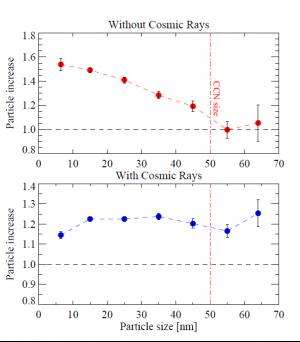Danish experiment suggests unexpected magic by cosmic rays in cloud formation

According to the theory, small clusters of molecules in the atmosphere have difficulty growing large enough to act as "cloud condensation nuclei" on which water droplets can gather to make our familiar low-altitude clouds. The SKY2 experiment shows that the growth of clusters is much more vigorous, provided ionizing rays—gamma rays in the experiment or cosmic rays in the atmosphere—are present to work their chemical magic. Details of the experiment appear in the latest issue of Physics Letters A.
Back in 1996 Danish physicists suggested that cosmic rays, energetic particles from space, are important in the formation of clouds. Since then, experiments in Copenhagen and elsewhere have demonstrated that cosmic rays actually help small clusters of molecules to form. But the cosmic-ray/cloud hypothesis seemed to run into a problem when numerical simulations of the prevailing chemical theory pointed to a failure of growth.
Fortunately the chemical theory could also be tested experimentally, as was done with SKY2, the chamber of which holds 8 cubic metres of air and traces of other gases. One series of experiments confirmed the unfavourable prediction that the new clusters would fail to grow sufficiently to be influential for clouds. But another series of experiments, using ionizing rays, gave a very different result, as can be seen in the accompanying figure.
The reactions going on in the air over our heads mostly involve commonplace molecules. During daylight hours, ultraviolet rays from the Sun encourage sulphur dioxide to react with ozone and water vapour to make sulphuric acid. The clusters of interest for cloud formation consist mainly of sulphuric acid and water molecules clumped together in very large numbers and they grow with the aid of other molecules.
Atmospheric chemists have assumed that when the clusters have gathered up the day's yield, they stop growing, and only a small fraction can become large enough to be meteorologically relevant. Yet in the SKY2 experiment, with natural cosmic rays and gamma-rays keeping the air in the chamber ionized, no such interruption occurs. This result suggests that another chemical process seems to be supplying the extra molecules needed to keep the clusters growing.
"The result boosts our theory that cosmic rays coming from the Galaxy are directly involved in the Earth's weather and climate," says Henrik Svensmark, lead author of the new report. "In experiments over many years, we have shown that ionizing rays help to form small molecular clusters. Critics have argued that the clusters cannot grow large enough to affect cloud formation significantly. But our current research, of which the reported SKY2 experiment forms just one part, contradicts their conventional view. Now we want to close in on the details of the unexpected chemistry occurring in the air, at the end of the long journey that brought the cosmic rays here from exploded stars."
More information: "Response of cloud condensation nuclei (>50 nm) to changes in ion-nucleation", H. Svensmark, Martin B. Enghoff, Jens Olaf Pepke Pedersen, Physics Letters A 377 (2013) 2343-2347.
Journal information: Physics Letters A
Provided by Technical University of Denmark




















